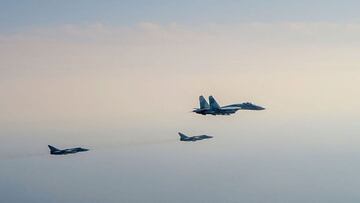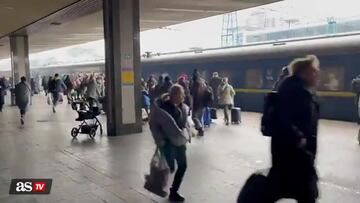What is a no-fly zone and why hasn't NATO initiated one?
As the invasion of Ukraine by Russia continues, and innocent civilian bodies continue to be collected, NATO refuses to act on the ground and in the sky.

As NATO foreign ministers meet in Brussels for the latest discussions on Russia's unprovoked invasion of Ukraine, Kyiv once again called on Western allies to implement a no-fly zone or provide them with more planes to protect civilians and infrastructure including nuclear plants.
No-fly zone or planes requested by Ukraine
Ukrainian President Volodymyr Zelenskyy (learn more about that surname) has consistently called for a no-fly zone since Moscow's invasion more than a week ago, but NATO allies have resisted a step that could drag them into the war with nuclear-armed Russia. Speaking ahead of the meeting in NATO's Brussels headquarters, Lithuania said the alliance would be dragged into the war if it were to enforce a no-fly zone.
More on Russia-Ukraine conflict:
"All encouragements for NATO to get involved into the military conflict now are irresponsible," said Lithuanian Prime Minister Ingrida Simonyte.
Meanwhile, Canadian Foreign Minister Melanie Joly said that NATO's red line was to avoid triggering a wider international conflict, but said all scenarios should be discussed. France's presidential office described a no-fly zone as "a very legitimate request and very difficult to satisfy."
With Russian forces seizing the largest nuclear power plant in Europe on Thursday and the Azov Sea port of Mariupol having been encircled and left without electricity or running water by heavy Russian bombing, Zelenskyy said that if allies wouldn't meet his request to protect Ukrainian air space, they should instead provide Kyiv with more war planes.
But what is a no-fly zone, and why is NATO so reluctant to provide it?
No-fly zone: it’s all or nothing
A no-fly zone, which you may have also heard being called an air-exclusion zone or a no-flight zone, is a fairly recent addition to international interventions, starting in the early 1990s, and aims to do exactly what it says. It creates an area over which certain aircraft are not allowed to fly, and the military power setting the zone would protect it, often by force. This enforcement of the territory can take different forms, from shooting down planes, helicopters or, these days, drones, breaking the order, as well as preventative measures such as taking out command and control centres or involving surveillance activity.
Previously we have seen official no-fly zones established in Iraq (1991-2003), Bosnia and Herzegovina (1993-1995), and Libya (2011, 2018, 2019). What differs them from the current situation is the potential repercussions of enforcement, given Russia’s nuclear arsenal.
The idea of implementing a no-fly zone over Ukraine seems simple enough, and has been pushed by several commentators over the past week. Effectively it would mean banning any aircraft from flying over the country, removing the potent aerial attack of the Russian bombing tactics. But it comes with some rather unpleasant side orders, hinted at earlier.
Why NATO is avoiding Ukraine no-fly zone
Firstly, it would also prevent the Ukrainian air force - albeit a much more limited one - from carrying out operations, for example, like that targeting the giant convoy of Russian military vehicles. More importantly, however, is that it would almost certainly escalate the war to a continental or global scale, potentially with truly devastating results.

There is little point in NATO and its allies applying the restrictions unless they are willing to fully enforce them. And given Vladimir Putin’s form, he is unlikely to pay much attention. That would see Russian attacks continue in the sky, and NATO would fire on the planes, and potentially the guidance units, which could be based in Putin’s homeland. For some military analysts, that’s exactly what the dictator wants to support his propaganda that the West is a threat.
What comes next no one can predict. But with the nuclear option in play, it’s too big a risk for NATO to take. At least for the moment.






